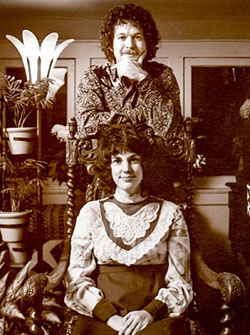Guild Screenings
Gloria Katz & Willard Huyck Revisit American Graffiti on its 45th Anniversary

American Graffiti writers Gloria Katz & Willard Huyck in 1972.
On Friday, September 14, the Guild Screenings presents a Q&A with American Graffiti writers Gloria Katz & Willard Huyck. It will be moderated by one of the film's stars, Charles Martin Smith, following a special 45th Anniversary screening of their landmark coming-of-age film.
We spoke to them, and the legendary screenwriters fondly remembered the experience and working with director/co-writer George Lucas and producer Francis Ford Coppola.
How did you originally get involved with the project?
George had made the dystopian THX-1138. Not exactly a box office hit. Francis suggested George do something “funnier” next time. And we were the only screenwriters that George knew.
How did the writing process work with George?
It was a blast, as we used to say. We got to reminisce about high school friends, enemies, antics and traumas—and stick them into a movie.
We also saw ourselves as the characters—Gloria was Cindy Williams, Willard was Rick Dreyfuss, George saw himself as the tough hot-rodder Paul Le Mat. We actually saw George as the loveable Terry the Toad. And who knew George would become “Citizen Kane,” whose last wistful words will be...“Deuce Coupe....”
How do you two work as a married couple AND writing partners? Do you have a rule about turning off the work at a certain point?
The problem is usually turning on the work. Every morning we look across our partner’s desk and say, “You got any ideas?”
Did you work with George through production?
Our early input was screening [Federico] Fellini’s I Vitelloni for George and Francis and describing how the [Arthur] Schnitzler play La Ronde was structured. And having it take place in one night, which became a production nightmare. Other input was regarding casting. We had seen Rick Dreyfuss in an Israel Horovitz play and pushed for George to use him. We later ignored critics’ comments, wondering why Rick's character had such Waspy parents.
How personal was this film for the two of you to write?
It was very personal, because we were George’s Cali contemporaries. Willard had cruised Bob’s Big Boy in his ‘38 Buick with a rumble seat. Gloria had feasted on fries with the rich kids at Dolores Drive-In in Beverly Hills. So, we shared 1962 with George. Except he was a senior and we were juniors—which seems to make less of a difference as time goes by.
The soundtrack for the film is renowned. Did you have songs in mind when you wrote it?
George had the songs in his mind even before there was a script. So, yes, we put George’s selections for what Wolfman [Jack] was going to play on the radio behind each scene.
Any scene or moment you’re each most proud of?
We were quite fond of the goat killer sequence, the pushy car salesman in the giant rocking chair, and Candy Clark saying it was such a bitchin’ night and then recounting all the disasters that had taken place. Of course, these were the scenes our studio executive wanted to cut out of the movie!
The film was incredibly popular and influential. Were you surprised by how widespread the love was?
We remember that after the first screening, a friend said, “This is going to be bigger than EASY RIDER!” And we assumed he was on hallucinogens.
